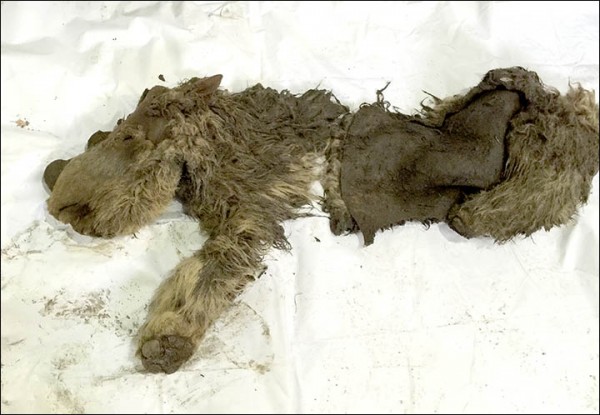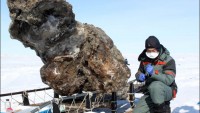Extinct Baby Woolly Rhino Specimen Discovered; Scientists Consider ‘De-Extinction’
| Marco Foronda | | Mar 13, 2015 09:19 AM EDT |
(Photo : Academy of Sciences Republic of Sakha) The preserved woolly rhino specimen, "Sasha," discovered in Siberia.
A rare specimen of an extinct baby woolly rhinoceros (Coelodonta antiquitatis) was discovered in Siberia, an event that has excited Russian paleontologists.
The preserved remains of a 10,000 year-old woolly rhino calf, "Sasha," is the only complete specimen unearthed to date. It was named after Alexander "Sasha" Banderov, the businessman and hunter who discovered it in a frozen stream.
Like Us on Facebook
The specimen measures 0.8 meters high and 1.5 meters long. In contrast, an adult woolly rhino measures 1.9 meters high and 4.5 meters long, according to a report by Albert Protopopov, head of the Mammoth Fauna Studies Department of Yakutian Academy of Sciences, translated by Olga Potapova of Mammoth Site of Hot Springs.
It has a thick fur and two horns tightly attached to its skull. It's estimated to be between 3 to 4 years old, Paleontological Institute's Evgeny Maschenko said via Potapova.
In addition, Maschenko suspected Sasha was already weaned from its mother based on the size of the horns. The researcher could not determine its gender, however.
Data on woolly rhino calves are lacking as specimens are very rare, Protopopov said. This is why they were lucky to find Sasha, he added.
The researchers' aim to extract Sasha's DNA and determine where it belongs in the rhino family tree and identify the species' close relatives.
Moreover, they're consider the possibility of cloning its DNA to bring the species back to life. The "de-extinction" process where a species' DNA is cloned and bred in a related animal was originally proposed for the woolly mammoth by some scientists.
The idea of applying it on the woolly rhino has excited scientists with the discovery of the preserved specimen, reports said.
It's too complicated using the traditional methods as the woolly rhino has no close living relatives, Protopopov said.
Woolly rhinos are estimated to have walked on earth in the Pleistocene epoch about 350,000 years ago. They became extinct 10,000 years ago and scientists identified climate change as the more probable cause of extinction and not overhunting.
Tagswoolly rhino, Siberia, Yakutian Academy of Sciences, Sasha
©2015 Chinatopix All rights reserved. Do not reproduce without permission
EDITOR'S PICKS
-

Did the Trump administration just announce plans for a trade war with ‘hostile’ China and Russia?
-

US Senate passes Taiwan travel bill slammed by China
-

As Yan Sihong’s family grieves, here are other Chinese students who went missing abroad. Some have never been found
-

Beijing blasts Western critics who ‘smear China’ with the term sharp power
-

China Envoy Seeks to Defuse Tensions With U.S. as a Trade War Brews
-

Singapore's Deputy PM Provides Bitcoin Vote of Confidence Amid China's Blanket Bans
-

China warns investors over risks in overseas virtual currency trading
-

Chinese government most trustworthy: survey
-

Kashima Antlers On Course For Back-To-Back Titles
MOST POPULAR
LATEST NEWS
Zhou Yongkang: China's Former Security Chief Sentenced to Life in Prison

China's former Chief of the Ministry of Public Security, Zhou Yongkang, has been given a life sentence after he was found guilty of abusing his office, bribery and deliberately ... Full Article
TRENDING STORY

China Pork Prices Expected to Stabilize As The Supplies Recover

Elephone P9000 Smartphone is now on Sale on Amazon India

There's a Big Chance Cliffhangers Won't Still Be Resolved When Grey's Anatomy Season 13 Returns

Supreme Court Ruled on Samsung vs Apple Dispute for Patent Infringement

Microsoft Surface Pro 5 Rumors and Release Date: What is the Latest?












